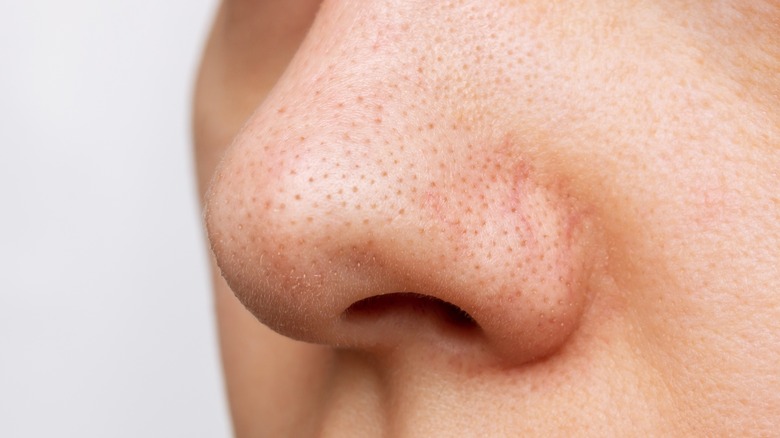Things You Might Not Know About Silent Migraines
On the surface, the term silent migraine doesn't seem to make sense. After all, if you look up the word "silent" in the Merriam-Webster dictionary, you'll see a number of entries all related to sounds. However, you'll find that silent can also mean "not exhibiting or producing the usual signs or symptoms of presence."
In other words, unlike other types of migraines that cause severe pain — think the world's worst headache — silent migraines don't (via American Migraine Foundation). In fact, they're often called "migraine aura without headache." This is because there are four typical stages of a migraine attack, and the aura stage usually precedes the pain stage when the headache might (or might not) occur, per the Cleveland Clinic. And yes, the aura stage, as well as all the other common stages, has its own symptoms that can, in some cases, be debilitating even if the migraineur doesn't experience a bad headache.
Of course, everyone is different, and so not every person who gets a migraine is going to have the exact same symptoms. But that doesn't mean there aren't certain possible red flags of silent migraines — some of which might not be obvious. Becoming aware of them could help you and your health care provider find ways to treat them, so they won't be as disruptive to your life.
They can impact your time in the bathroom
Although it's possible to skip different stages of a migraine attack, the first two stages are typically the prodrome phase and the aura phase (via WebMD). Even if you're experiencing a silent migraine, you could still go through both of these stages. What's more, it's possible to mistake some of the symptoms of the different stages of a migraine attack for a different health concern.
For example, when a person is in the prodrome phase, they might need to urinate more often than usual. But as the Mayo Clinic explains, more frequent urination can also be related to conditions like both type 1 and type 2 diabetes. It also might happen if someone has an anxiety disorder. Women who are pregnant typically need to go more often. And of course, drinking large amounts of caffeinated or alcoholic beverages can lead to more bathroom visits. The point is, it can be very easy to miss needing to go "number 1" more often as a signal that you might be at the beginning of a silent migraine attack.
Besides affecting urination, the prodrome phase of a silent migraine can also affect your bowel movements, leading to either diarrhea or constipation. But again, this can be hard to recognize since, as the Cleveland Clinic notes, factors like not eating enough fiber can lead to constipation. Plus, infections and certain medications can cause diarrhea (per the National Institute of Diabetes and Digestive and Kidney Diseases).
Silent migraines can affect your vision
If you guessed that the aura phase of a migraine (including a silent migraine) affects one's vision, you'd be mostly correct. The aura stage actually can impact more than just your sense of sight, and we do explore some of its other possible symptoms elsewhere in this article. But yes, migraineurs do sometimes experience changes to their eyesight.
In fact, according to the Cleveland Clinic, a hallmark of a type of silent migraine known as an ocular or ophthalmic migraine is how it interferes with one's vision. For example, someone experiencing this type of migraine could see flashes of light, spots, or zig-zags. They also might have double vision or even lose their vision entirely (but only temporarily). And while these vision problems could affect both of the eyes, they also might only affect one eye.
If you're unaware that these vision issues can happen because of a silent migraine, they can be frightening. "A patient may think something is wrong with their eye, or if it's an elderly patient, they might worry they are having a stroke," headache specialist Dr. Emad Estemalik told the Cleveland Clinic. With that said, these kinds of vision issues can be red flags of other health concerns besides silent migraines. So, if you're experiencing changes in your eyesight, you should have yourself examined by a medical professional just to be safe.
You might have issues with your hearing
While the aura stage of migraines can impact one's vision, according to Upper Cervical Awareness, it can also interfere with a person's sense of hearing. This includes the migraineur experiencing a silent migraine where they're hearing sounds that aren't actually there.
Silent migraines can cause tinnitus. This is when a person hears sounds like whistling, buzzing, chirping, hissing, or ringing even though there's no external source for these noises (via WebMD). How loud they are and how often the person hears them tends to vary. Make no mistake, though — having tinnitus can be very disruptive. For one thing, imagine trying to fall asleep at night while your ears won't stop ringing. And in case you're wondering, yes, migraines that cause headaches can also have tinnitus as a symptom.
In addition to tinnitus, silent migraines (as well as other migraines) can cause auditory hallucinations (per Upper Cervical Awareness). As a matter of fact, WebMD notes that it's not uncommon for someone with a migraine to hear voices, especially if they also have depression. Plus, tinnitus ups one's chances of experiencing auditory hallucinations. Furthermore, migraines in general can muffle one's hearing and/or cause a fullness sensation in one's ears. Of course, if you experience any hearing issues, you should make an appointment with your health care provider.
They can throw off your balance
In the movies, when someone is overcome by an illness, they often become unsteady on their feet and collapse. While this might seem a bit dramatic, that doesn't mean this classic trope isn't based in reality. For example, according to WebMD, a possible symptom of silent migraines is experiencing vertigo.
Now, just to clear up one misconception, while sometimes vertigo and dizziness are used interchangeably, having vertigo goes well beyond feeling dizzy (via the National Health Service). When someone has vertigo, they feel as if their surroundings are spinning. Since this sensation can be strong enough that a person might have difficulty maintaining their balance, it's a good idea to sit down during a bout of vertigo to avoid falling and sustaining injuries. If you do need to walk, you might want to use cane and move slowly. Lying down in a dark room without noise can also help with vertigo. And even though everything spinning can be frightening (especially if you're not sure about the cause), panicking can worsen vertigo.
It's important to note that vestibular migraines can also cause vertigo, as well as balance issues and sensitivity to motion (per Johns Hopkins Medicine). And while vestibular migraines can cause headaches, it's possible to experience one and not have severe head pain.
They can affect your mood
Think about the last time you weren't feeling well. Chances are whatever was ailing you affected your mood. Maybe you felt extremely down. Or perhaps things that normally wouldn't bother you suddenly were getting under your skin. Well, both of these emotions are possible for someone with a silent migraine — along with others you might not expect.
According to Medical News Today, different phases of a silent migraine attack can impact one's mood. For example, what is usually the first phase, the prodrome phase, can sometimes cause depression, as well as make the migraineur more irritable. They also might experience a wide variety of emotions during the third stage of a silent migraine, ranging from feeling depressed to feeling anxious to even feeling giddy. Fun fact: This third phase is when the severe headache occurs in other types of migraines.
In addition to possible changes in mood during the first and third stages of a silent migraine, a migraineur could have extreme highs and lows in their emotions during the fourth stage. Known as the postdrome phase, this stage usually lasts for a day or two, during which time a person might experience depression or euphoria. So if you know someone who gets migraines, and their mood seems off during one of their attacks, please keep in mind that you might be witnessing symptoms of their condition.
Silent migraines can cause fatigue
Of course, not feeling well can make one tired. And sometimes, a little rest is all that's needed to help recharge one's batteries. However, according to MedicineNet, someone with a silent migraine might experience a type of low energy that goes beyond this type of tiredness.
As MedicineNet explains, being fatigued — like someone with a silent migraine might experience — can affect a person both physically and mentally. For instance, let's say you enjoy gardening. It's one of your favorite hobbies, and you don't mind a little hard work because the results are worth the effort. But if you're feeling fatigued, then you might find you don't feel as motivated when it comes to your gardening. It might be more difficult to start a new gardening project, and even after you get going, you could become more tired than usual. Additionally, you might find it harder to concentrate on what you're doing and have difficulty finishing your gardening project.
Another thing to keep in mind when it comes to fatigue and silent migraines is that some of the symptoms either directly or indirectly connected to each condition overlap. The symptoms of a silent migraine can include vomiting and diarrhea. Medical News Today states that anxiety and depression can occur during a silent migraine attack. And all four of these health concerns are symptoms associated with fatigue (via MedicineNet).
You might get food cravings
On the classic sitcom "I Love Lucy," a pregnant Lucy dunks a dill pickle into a papaya juice milkshake and takes a big bite, much to her husband Ricky's disgust. Even a newcomer to the series would connect the dots that Lucy is having food cravings because she's expecting. But pregnancy isn't the only reason someone might suddenly want certain foods.
According to Single Care, it's common for someone in the first stage of a silent migraine attack to have food cravings. But this shouldn't be a surprise, since food cravings and migraines in general can go hand in hand (via Migraine.com). Specifically, foods that contain large amounts of sugar, salt, or fat tend to be on the top of the list of what a migraineur might reach for during an attack. Exactly why this happens is still being explored, but one theory is that migraines might affect the pleasure and reward area of the brain. Another possible reason is that migraines can throw hormones out of balance, possibly resulting in food cravings.
Beyond craving a specific food, migraines can also just ramp up someone's hunger in general. Fortunately, there's a simple way to help control such non-selective hunger cravings: Drink water. So if you are a migraineur, you might want to note the next time you get food cravings. If there isn't a reason (like dinnertime), this could be a warning sign that you're in the first stage of a migraine attack.
They can make you feel like Alice in Wonderland—sort of
In Disney's "Alice in Wonderland," the title character learns that eating or drinking certain foods in this strange, underground world can change her size. During an encounter with the White Rabbit, she finds out eating a carrot can shrink her down when she unexpectedly grows much larger inside of his house. In another scene, she's told that a mushroom can make her either taller or shorter, depending on which side of it she eats.
Now, to be fair, a person with a migraine (silent or otherwise) isn't going to sudden find themselves the size of a mouse or as tall as a redwood tree. But as Everyday Health explains, they might experience what's known as Alice in Wonderland syndrome or AIWS. When this occurs, they suddenly might think that, say, a lamp in their bedroom looks larger or smaller than normal, even though it obviously hasn't changed in size. And it doesn't stop there. While Alice literally became bigger and smaller, a person with AIWS might say that their hands, feet, or other parts of their body look noticeably larger or tinier.
Although this might sound disconcerting, there is some good news: AIWS isn't common. However, there is also some bad news. As neurologist Dr. Anjan K. Chatterjee told Everyday Health, AIWS can also happen if someone has conditions like temporal epilepsy or viral infections, including the flu and mononucleosis (a.k.a. mono).
Silent migraines can make you numb
Although a silent migraine doesn't cause a severe headache, that doesn't mean it can't trigger other unpleasant sensations. According to Greatist, a person having a silent migraine attack might experience tingling. And no, this isn't limited to the head. Basically, any part of their body could have a "pins and needles" sensation. In addition, they also might have numbness.
Tingling and numbness can occur for migraines in general (via Migraine.com). When they do happen, they typically occur during the second phase of a migraine attack, and can be warnings that a severe headache is on the way. Of course, this isn't the case with silent migraines, but that doesn't mean these possible symptoms aren't disruptive. For instance, a migraineur might experience numbness in areas of their limbs like the fingers, arms, and legs. Other parts of the body that can become numb during this phase include the head, the face, the lips, and the tongue.
At this time, we're still learning about migraines and why these tingling and numbing sensations occur in some patients. But that doesn't mean there aren't patterns to alert a migraineur that a "pins and needles" sensation could be signaling a migraine is on the way. The Mayo Clinic explains that sometimes, numbness and tingling spread slowly through the arms or legs. Also, migraine-related numbness sometimes only affects either the left or right side of the body.
Can you get amnesia from them?
For many people, their idea of amnesia is the entertainment trope where a character bumps their head and suddenly can't remember who they are. However, not all types of amnesia involve such a dramatic level of memory loss.
As the Cleveland Clinic explains, someone with transient global amnesia (TGA) wouldn't be asking "Who am I?" or saying to their spouse "Who are you?" Such memories normally remain intact for a person with this condition. However, if you were to ask them what they had for breakfast that morning, they might not be able to remember, since TGA can affect how a person recalls recent memories. Also, a patient with TGA usually is unable to form new memories. And yes, having a migraine might be a risk factor for this form of amnesia. In fact, Migraine.com lists amnesia as a possible symptom of a silent migraine.
In all fairness, TGA isn't common (via the Cleveland Clinic). But it's still important to be aware of the potential signs of it. If you suspect that a person might have TGA, trying asking them questions like what day it is, what time it is, and where they are. If they have trouble answering them, that can be a sign of this form of amnesia. Also, a person with TGA might experience nausea, vomiting, and tingling in different parts of their limbs, which are all possible symptoms of silent migraines.
They can make you yawn, tired or not
Migraines and silent migraines can have the same symptoms — minus the severe headache, of course (via the Migraine Relief Center). Take yawning, for example. Someone with either a migraine or a silent migraine might find themselves yawning, even though they don't feel tired. In fact, according to Upper Cervical Awareness, a migraineur might find that they're yawning over and over again for no apparent reason. But of course, there is a reason.
Before we go any further, we need to talk about our spine and how it can impact our breathing. As the American Association of Neurological Surgeons explains, there are seven bones in our neck, which are referred to as the cervical spine. When this area of our skeleton is out of alignment, that can negatively impact our breathing. Our bodies might compensate by making us yawn, which forces use to take in more oxygen, per Upper Cervical Awareness. As a matter of fact, tThe Migraine Relief Center notes that a migraineur might experience stiffness in their neck during the same stage that they might find themselves constantly yawning.
The good news is yawning — and for that matter, neck stiffness — typically occur early on in a migraine attack. This can make constant yawning a useful warning signal, especially if it's accompanied by neck stiffness.
Your nose might experience hallucinations
When most people think of hallucinations, it's usually either seeing or hearing something that isn't there. However, as Upper Cervical Awareness points out, a person with a silent migraine might find that their sense of smell is being affected.
A study looking at over 2,100 migraine patients and more than two dozen medical cases found that migraineurs can experience phantosmias (a.k.a. olfactory hallucinations), per Migraine.com. This form of hallucination can happen during the second stage of a migraine attack (the aura phase). The study noted that the patients who experienced these olfactory hallucinations typically described a burning scent like cigar smoke or overcooked popcorn or wood burning. The second most common phantosmias was a scent similar to sewage or garbage. There were also cases of patients thinking they were smelling coffee or oranges. It's important to note, though, that patients in this study who experienced phantosmias didn't usually report sweet smells.
That said, experiencing phantosmias during a migraine isn't a common occurrence. In fact, only 14 cases in that study involved patients reporting olfactory hallucinations. And given how rare they are, it's possible for some migraineurs to not recognize these hallucinations as symptoms of their condition. So the next time you experience a migraine (which hopefully won't be for a very long time), try to take note of any odd scents, so you can let a medical professional know about this potential symptom.
They can make you nauseous
Since a severe headache is such a hallmark of many types of migraines, it's understandable if someone assumed that pain triggered another common migraine symptom: nausea. However, as GoodRx points out, nausea is a typical symptom of a silent migraine. But while we understand that, there are still many unanswered questions when it comes to this potential migraine symptom.
Yes, migraines can come with nausea and even vomiting, but at this time, we're not sure why (via the Pain Center of Arizona). There are theories, of course, such as a possible link between one's blood pressure becoming higher during a migraine and becoming nauseous. A drop in the levels of the chemical serotonin could also be the culprit behind migraine-related nausea. And since migraines are more common in women, the scientific community is also exploring if estrogen levels are responsible for the nausea some migraineurs experience.
Regardless of why silent migraines (as well as other kinds) cause nausea, there are some simple ways to help sooth your stomach during an attack. Slowly sipping ginger ale that contains real ginger, as well as flat 7-UP, could help ease nausea. You also might want to try nibbling on bananas or crackers. And of course, speak with your health care provider. They might be able to prescribe something to help with migraine-related nausea.
They can give you brain fog
Imagine this: You go to bed, but as soon as your head hits the pillow, your neighbor's dog starts barking and keeps you up for most of the night. The next day, you're exhausted and have trouble paying attention during an important meeting. No matter how hard you try, you just can't seem to focus on anything the way you normally would. As Verywell Mind explains, this is brain fog, which can happen when you don't get enough sleep. However, according to the Association of Migraine Disorders, it also can be a symptom of a silent migraine.
Brain fog doesn't usual happen on its own (vvia Verywell Mind). Rather, it's a sign of another condition. And that difficulty with focus and general mental fuzziness can impact one's life in ways beyond the above hypothetical scenario. For example, someone experiencing brain fog might have problems carrying on a conversation. They might find multitasking more challenging than normal. Additionally, it can also affect their memory. But one of the potentially more dangerous aspects of brain fog is that the person might be less aware of their surroundings. In theory, someone with brain fog could cross the street at the wrong time and run the risk of being hit by a vehicle.
Besides silent migraines, brain fog can occur because of other health concerns like perimenopause, dementia, and depression. Stress and brain fog can also go hand in hand.















